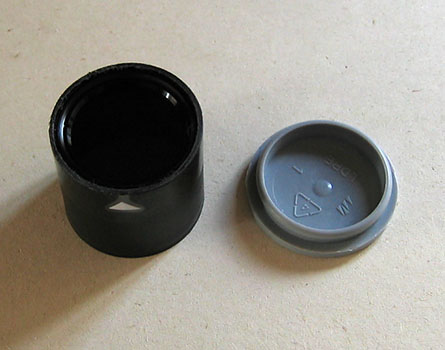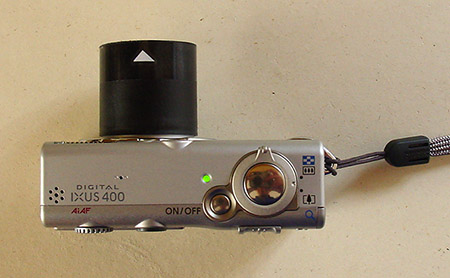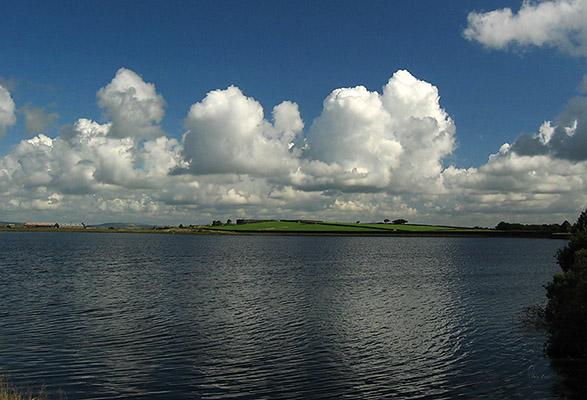
Adding filters to small digital cameras.
By Ian Walker. UK.
A simple method of adding accessory filters to digicams without threaded lenses or filter adapters.
I like my Canon Ixus 400 digital camera but like many others of its type it is difficult to use a polarizing, UV or other filters with it unless you hold the filter in front of the lens, possibly obscuring part of the lens with one of your fingers! Another problem is that you are more likely to introduce camera shake because you are trying to hold the filter with one hand, the camera with the other, together with possibly losing a couple of 'f' stops with some filters. The great thing about these small cameras is that you can carry them about with you all the time, my Canon goes with me on virtually every outing, but I don't like to be without a polarizer.
The simple adapter I made for the Canon is made from a standard 35mm film case but the idea can be adapted for other small digicams by looking in your kitchen for plastic vitamin containers or the like to find which one will fit snugly around the digicam lens barrel whilst still allowing the focus mechanism to move freely. The filters themselves can be bought to fit the tube since single coated Hoya filters etc can be bought now in many sizes for around £11. I cut the end off the 35mm case to leave a tube 31mm long, the tube is an excellent fit on the Canon Ixus allowing free rotation of the adapter but not sloppy enough to fall off. When cutting the tube with a hacksaw it is important to be gentle and not put too much force on the blade as this will cause the tube to distort and you will end up with a mess!
Once you have cut the end off, sand down any ragged edges to leave a smooth finish and then rinse the tube under a tap to make sure there are no small deposits stuck inside, don't throw away the clip on lid since this now prevents dust entering the tube when the adapter is not being used. I found that my old set of 28mm Nikon Coolpix 4500 filters fit inside the tube, with the help of a single turn of insulation tape cut to fit the height and circumference of the filter this gives a semi-permanent fit but can easily be pushed out of the tube to recover your filter.
The Nikon polarizer rotates in its mount but this turning action is not required since you now switch on your camera allow the lens to come out and push on your home made adapter - you now have a large area of adapter available to rotate your polarizer about the lens. Note the white marker in Fig 1. this has been accurately aligned to coincide with the polarization direction marker on current Hoya filters, read on for the reason behind this. It can be achieved in doors in any weather conditions by looking at a gloss painted surface on a window sill and rotate for minimum reflections, this will be well defined, then put a temporary marker on the tube until you can stick on a permanent mark. I can now rotate the Hoya and my filter and the polarization effect remain in sync through 360 degrees. One added benefit of the design is the fact that you can zoom from minimum to maximum but hold the adapter as this keeps the polarization effect you want throughout the zoom range. With some cameras the lens rotates as you zoom requiring re-adjustment of the polarizer for each zoom setting.

Fig 1.Completed filter adapter showing Nikon Coolpix 4500 polarizer fitted.
It is important to cut the length accurately since leaving the tube too long may introduce vignetting, I have had no problems with mine. If you like using a UV and polarizing filters you can make up two tubes rather than fiddling about trying to push each filter into the tube in the 'field'. Not using a polarizer on your digicam especially in summertime can severely restrict creativity losing the rich blues of the sky and well defined cloud structure together with the creative potential at ponds, reservoirs etc. At the moment nobody has a Photoshop plug-in that can emulate a polarizer or the extra definition that a UV filter can have on hot summer days.

Fig 2. Adapter fitted to Canon Ixus 400.

Fig 3. Excellent cloud definition with polarizer fitted.
Using your polarizing adapter together with a rangefinder film camera.
When I am on one of my longer photographic trips I like to use both the Canon and my rangefinder film camera. If you have ever tried using polarizers with rangefinders they are a lot of hassle since you first must remove the filter, look through it, find the position you want, screw it back on the camera and re-align the filter. If you keep the adapter in your pocket you can now use the your adapter to look through for best effect and then simply align the markers on the adapter and polarizing filter on the rangefinder camera.
the end.
Comments to the author, Ian Walker, are welcomed.
Published in the September 2004 edition of Micscape.
Please report any Web problems or offer general comments to the Micscape Editor.
Micscape is the on-line
monthly magazine of the Microscopy UK web
site at
Microscopy-UK
© Onview.net Ltd, Microscopy-UK, and all contributors 1995 onwards. All rights reserved. Main site is at www.microscopy-uk.org.uk with full mirror at www.microscopy-uk.net .